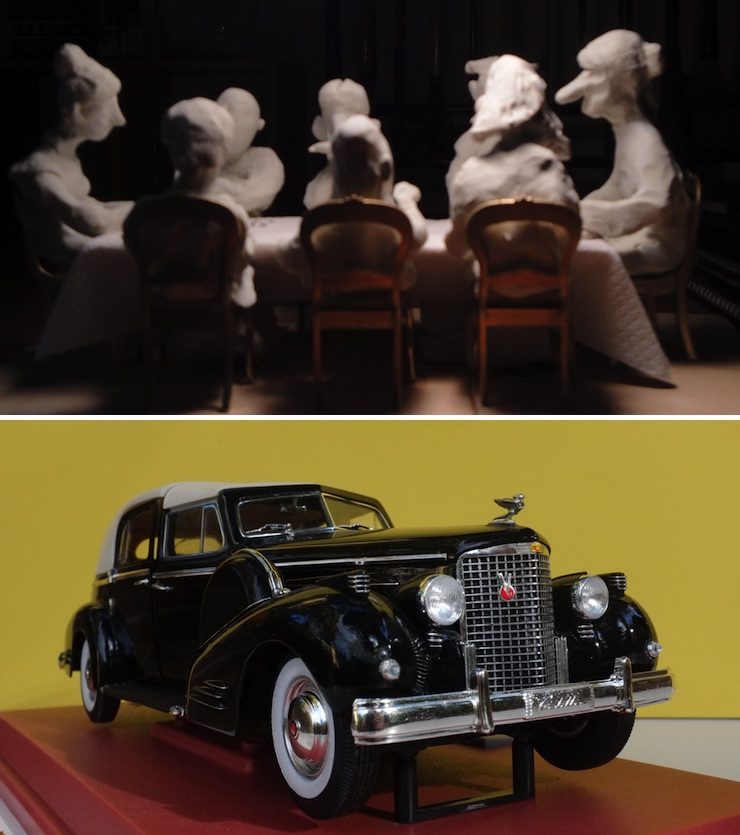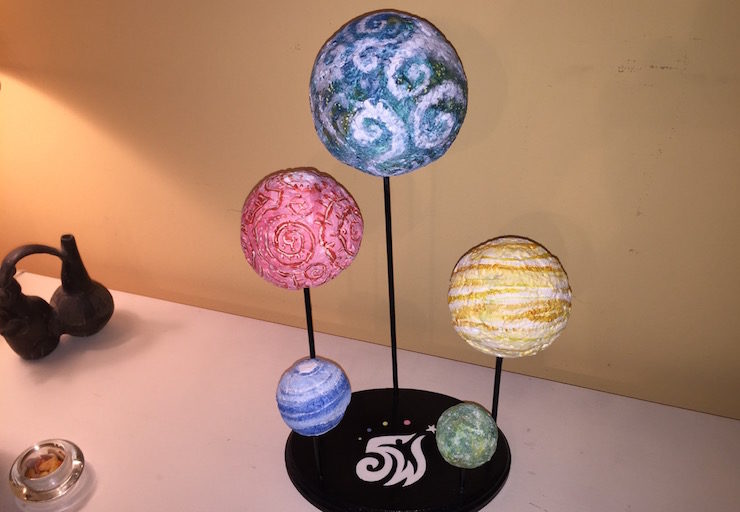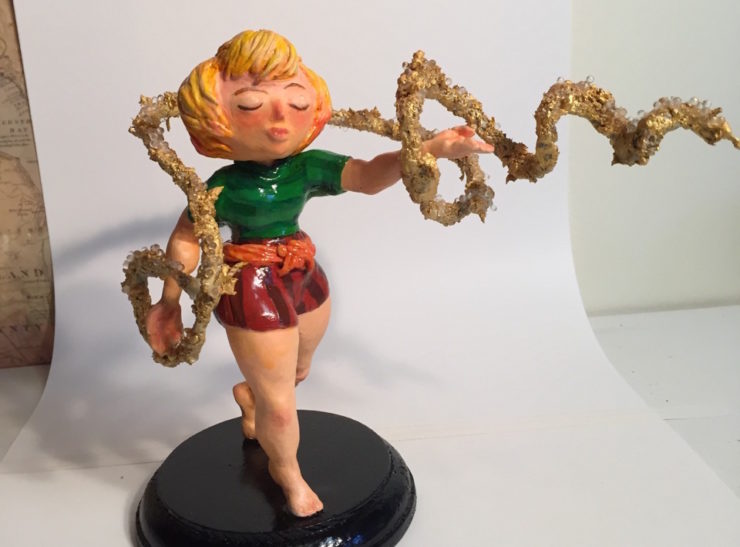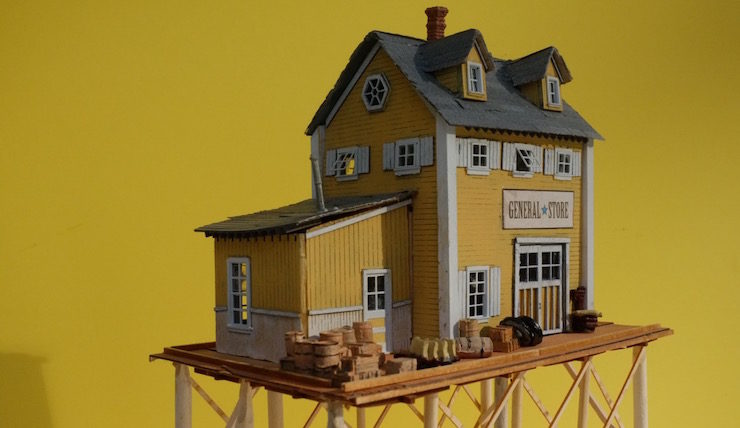In this ongoing series, we ask SF/F authors to describe a specialty in their lives that has nothing (or very little) to do with writing. Join us as we discover what draws authors to their various hobbies, how they fit into their daily lives, and how and they inform the author’s literary identity!
I’ve always loved miniatures. I remember being a toddler and gazing with amazement at a cousin of mine who made painstaking scale models, painting tiny, millimeter-high figures in a tiny WWII airplane cockpit. Something about small worlds spark my fantasy day-dreaming mind. Although I don’t collect them, I always admire the character models and figures on sale at every Comic Con.
For some years now, making miniature models of things and people has also become a vital piece of every project of mine. Above is a riverside General Store for a story that’s still germinating.
When I worked on Sailor Twain, a graphic novel set in the 1880s, I built the steamboat it’s set on, and a miniature version of its engine room, and made a number of little figures of various characters—including one key dinner scene which I staged on little doll-house furniture and cutlery.
For a picture book called Oskar and the Eight Blessings, I made characters in 1930s period clothing and also worked from a model of the Roosevelt presidential limo.

The value of making models goes beyond good visual reference for the final comics pages—way beyond. It turns out sculpting or building these little things is a way of getting out of my brain and into my feeling-life. It’s a way to spend time getting to know a character, a place, a vehicle—not just in my head, but with my fingers, and all my senses. The effect on the finished work is difficult to explain, but now it’s become essential to me. These little works can anchor an entire project as it’s taking form.
For this new SFF graphic novel series 5 Worlds, I’m with four teammates on a multi-volume epic story, and miniatures have accompanied us all along the way.
My first was a scale model of the worlds themselves—a mother world called Mon Domani, and its four moons, each with a different climate, culture, and history. I started with a wooden base and wooden stems, and Styrofoam balls. Then I build up the surface texture in a rugged paper-maché mix. After that I sprayed gray primer all over the elements (which are easily disassembled for traveling) and then started painting the five worlds’ signature looks. The final piece is varnished and our ‘5W’ logo is painted on. It’s a little more homespun than what you might display at a Comic Con booth, but it’s part of my own journey of getting acquainted with these worlds in a sensory way.

The heroine of 5 Worlds is Oona Lee. I got started on her using techniques from animation modeling. Based on a character sheet, I started with a wire-frame armature.
After that, I built it up with aluminum foil “muscles”, and over that, Magic Sculp layers. Magic-Sculp is a two-part resin mix, which hardens permanently in about 20 minutes, so I mix small amounts at a time, and patiently layer up the body.
Eventually, I’m making final touches to the sculpture. Notice that little copper wire—armature for a swirl of sand, still to come.
Then it’s time to paint the figure in acrylics. I use two different varnishes on the final figure, one matte, one glossy, depending on which part. Skin tends to be better matte.
Now about that little copper wire weaving around Oona’s arm—that’s the tricky part of this sculpture. Oona practices a magical artform called “Sand Dancing” and I wanted to show a swirling ribbon of sand around her figure. That turned out to be a little more difficult than I thought. In the end, I slowly layered stages of superglue, on which I sprinkled sand, tiny glass beads, and gold paint. I’d imagined something like smoky wisps of sand, but had to settle for something a little heavier looking.

As many writers know, some of the best invisible work of writing happens in the deep inner cooking, when we seem to be in a lull, or even procrastinating. These little sculpting projects are a bit of that, but they also serve to acquaint myself with a character in a visceral, tactile way. I’ve come to believe that experience makes the characters on the page just a little more credible, just a little more convincing because of it.
 Mark Siegel is an author and illustrator of many award-winning picture books and graphic novels, including the New York Times bestseller Sailor Twain, and the Jewish National Book Award winner Oskar and the Eight Blessings. His latest is 5 Worlds, a graphic novel series from Penguin Random House, in a five-way collaboration with his brother Alexis Siegel, and Xanthe Bouma, Boya Sun, and Matt Rockefeller. Mark also founded First Second Books, Macmillan’s graphic novel publisher. More on 5 Worlds: @5WorldsTeam on FB, Twitter and Tumblr.
Mark Siegel is an author and illustrator of many award-winning picture books and graphic novels, including the New York Times bestseller Sailor Twain, and the Jewish National Book Award winner Oskar and the Eight Blessings. His latest is 5 Worlds, a graphic novel series from Penguin Random House, in a five-way collaboration with his brother Alexis Siegel, and Xanthe Bouma, Boya Sun, and Matt Rockefeller. Mark also founded First Second Books, Macmillan’s graphic novel publisher. More on 5 Worlds: @5WorldsTeam on FB, Twitter and Tumblr.











Nicely done! I am a modeler also, but one who simply assembles and paints items crafted by others. I envy anyone who builds something from scratch.
When people see my miniatures collection, they immediately assume I know something about the games associated with those miniatures, but nope, I just like to paint things!